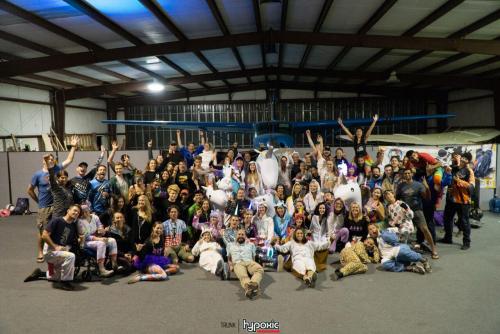5 Things You Didn’t Know About The PIA Symposium
Regina from CYPRES shares information about the CYPRES unit, 'WSC' designed for the wingsuit community. Images by Randy Connell
If you’ve never attended the Parachute Industry Association Symposium, you may not know what to expect. Maybe, you aren’t even sure what PIA is or why you even need to make the trip. If you’re afraid of sitting in stuffy rooms with an atmosphere as uncomfortable as a timeshare tourist trap, you can relax. PIA is nothing like that. The PIA Symposium is a time when the different branches of our particular segment of aviation all come together under one roof.
Rather than draw things out, let’s get to it. Here are 5 things you didn’t know about the PIA Symposium.
Just How Big the Skydiving Circle Is
When you arrive at the PIA Symposium, get ready for a warm welcome: there is an entire booth set up to greet you. Get your swag bag, name tag, and seminar schedule, and be ready for a great time. Like a drop zone on a sunny steady summer Saturday, the air is nearly buzzing with energy. In one space, jumpers current and retired, drop zone owners and managers, and military personnel and skydiving teams are all gathered together. You’ll see people from around the world. We know our circle is a somewhat isolated one, but boy, it sure doesn’t seem like it at the PIA Symposium. It’s also not just jumpers and drop zone owners from the United States that are present. You’ll walk past groups speaking languages from around the globe: military teams from Poland chatting, fun jumpers from South Africa mingling by the complimentary refreshments. Nearly every continent and country is represented.
Exponential Business Connections
At the PIA Symposium, you have the chance to establish meaningful industry contacts. Top gear manufacturers both military and civilian, set up impressive interactive displays and booths to give PIA Symposium attendees the chance to see the most cutting-edge innovations in the skydiving industry. Whether you are looking for training equipment or student gear, you will find what you need here. The EXPO Hall isn’t just for managers and drop zone owners either, there is gear on display that is perfect for weekend warrior skydivers too.
85 Year Old British Skydiver, Dilys Price was the Keynote Speaker at the 2017 PIA Symposium.
Ways to Improve your home Drop Zone
They say a ‘smarter skydiver is a safer skydiver.’ Well, the PIA Symposium is the perfect place to learn. The PIA Symposium facilitates knowledge sharing through seminars which are teeming with information. During the symposium, you have daily opportunities to sit in on seminars dealing with rigging, skydiving, management, government and skydiving interaction, and BASE. If you want to run a better, safer drop zone, attending PIA is a great first step. However, fostering safe drop zones isn’t just a job for managers and drop zone owners: the community as a whole is responsible. Whether sport jumper, manager, or drop zone owner, when you leave PIA, you leave armed with a noggin full of knowledge to take back home to your drop zone and improve everyone’s experience.
Everyone Feels Like a Potential Friend
You wouldn’t assume that you would leave any sort of symposium with some lifelong friends, would you? Well, you might just leave PIA with a few more telephone numbers programmed in your cell and a long list of drop zones to visit. No matter the level, ethnicity, or country of origin, it seems skydivers click. The PIA Symposium is basically a melting pot of like-minded people all connected by a love of skydiving and a passion for the sport and industry.
Sandy Reid of Rigging Innovations stands with his team. At the 2019 Symposium, RI introduces their new Mojo MARD.
Opportunities to Explore New Places
You don’t have to sit in seminars from sun up until sun down. Throughout the day, there are plenty of breaks and opportunities to explore. The PIA Symposium each year is held in charming cities with their own little secret niches and neat places to tour. This year is no different. The 2019 PIA symposium will be held in Dallas, Texas. So, grab a group of your new friends and do some sightseeing.
They say everything is bigger in Texas, and we bet this PIA symposium will be one of the best yet!

